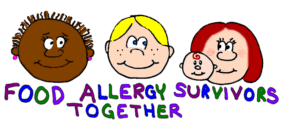|
|
Milk Allergy Print-out
By Linda Mahan and Jeni Cruts
Introduction
While there are different degrees of sensitivity and some allergic
individuals are able to tolerate some exposure to
dairy proteins, for most it is necessary to be totally dairy-free. Anything
that is derived* from milk will be
contaminated with dairy proteins. Goat's milk is not a good alternative for
most people. The proteins are not that
dissimilar.
*Derivatives of milk include: cream, butter, yogurt, cheese, whey, lactose,
casein (sodium caseinate), lactoglobulin,
lactalbumin, and various chemical names that include these. (Sodium
stearoyl lactylate is not supposed to be
derived from milk, so it should be safe.) Foods including these in the
ingredients should be avoided.
Read those labels
It is important to remember that manufacturers change ingredients in their
products all of the time. Remember to
check labels as they may change. What is safe one time may not be the next
time you buy it. Please use labels as a
guide only. Unfortunately the vague term "natural flavoring" can include
anything derived from any natural food
source. Contact the manufacturer if you are unsure of an ingredient.
When looking for dairy-free foods, you can look for the words "Pareve",
"Parve", or "Parevine". This is a Kosher term
meaning that the food contains no milk or meat. All Kosher food items are
labeled with the mark of the group that
inspects the food and manufacturing facilities. Some Kosher symbols are a
"U" with a circle around it; a "K" with a
circle, triangle or nothing around it; and there is also one which I can
best describe as a "K" with a flag on top and
bottom with a line connecting them on the left side of the K. If a Kosher
symbol is followed by a "D" it means that
Dairy is in the food or it is contaminated by dairy from the manufacturing
equipment. [NOTE: Shannon Wallace mentions that "if there is a 'DE' beside any Kosher symbol, it means that the product was processed on equipment that is also used to process dairy--which can be terrible for those with severe dairy sensitivities." She has also noticed dairy-free Kosher symbols on products that contain dairy in the ingredient list!]
Non-dairy does not mean dairy-free. The FDA allows
foods containing casein to be labeled "non-dairy."
Foods to be wary of
Surprise! Milk is a common ingredient in these foods (unless you make your
own).
Waffles, biscuits, cakes, cookies, crackers, donuts, packaged breads, rolls,
pie crust, pie filling, croissants,
chocolate, processed food - bologna, hot dogs, pepperoni, salami, sausage
(exception: Kosher meat products), cake
mix, coating mix for chicken, instant potatoes, "helper" dishes, breading on
fried foods, stuffing mixes, margarine.
So what can we have?
Air cakes; bouillon; broth based soups (watch out for milk in noodles);
condiments including: mayo, mustard,
ketchup; fish and seafood (if they are not breaded); fresh fruits and
veggies; frozen juice desserts and Italian ices;
jams; honey; Kosher-Pareve items; beef, marshmallows; fruit candies;
licorice; some dark chocolate (not Hershey's
anymore); milk-free margarine (Fleischmann's has
some Parve margarine
available in grocery stores); milk substitutes like enriched Rice Dream
or WestSoy; milk-free whipped cream,
pasta, potatoes, poultry (except some brands of self-basting turkey);
milk-free tofu cheeses (watch out for casein to
be an ingredient in some tofu cheeses); tofu based frozen desserts
Substitutions:
1 cup milk = 1 cup water or fruit juice plus 1 tablespoon oil or shortening
= 1 cup soy, rice, or nut drink (milk substitute)
= 1/2 cup milk substitute + 1/2 cup water
= 1/2 cup juice + 1/2 cup water
1 cup milk (for baking)= 1 cup water + 2 tablespoons milk-free margarine
1 cup buttermilk = 1/2 cup milk substitute + 1/2 cup water + 1 tablespoon
vinegar or
lemon juice
light cream = milk substitute
heavy cream = milk-free whipping cream or meringue
cream cheese = mayonnaise
Sour Cream = mayonnaise + 1 Tablespoon sugar
Nutrition Requirements:
For recommended daily allowances, visit: http://www.nal.usda.gov/fnic/etext/000105.html (Thanks to Jenn Borgesen for the link.)
Vitamin D:
Enriched milk substitutes have vitamin D added to them. You can find how
much on the label. However, the sun is an
excellent source. How much sun a person requires varies according to their
skin tone (darker skins require longer
exposure than lighter skins) and how much of the body is covered. It is
safe to say that it is less time than it takes to
burn. For most people 10-15 minutes per day is sufficient. In the cold
climates, it might be necessary to keep track
of the vitamin D being consumed internally.
|
